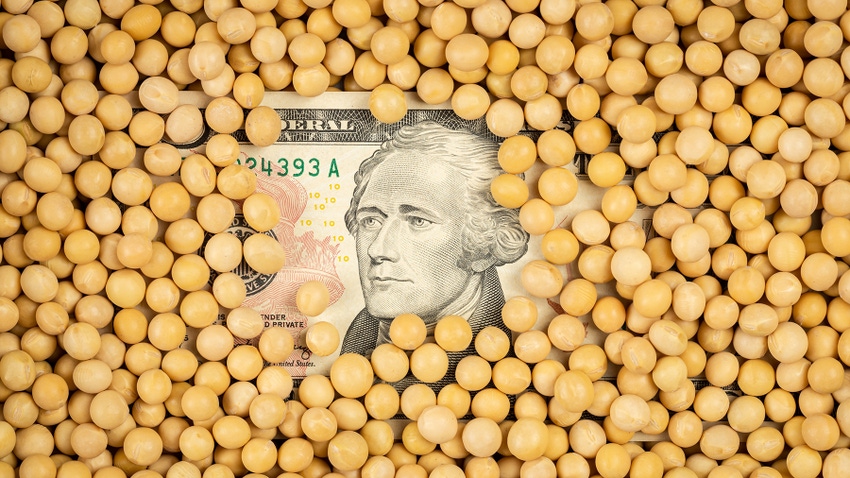
Soybeans have likely scored their fall lows at $12.505 basis November contract, the day of the October WASDE report last week. This low occurred as many producers were selling soybeans across the scales that they did not have on-farm storage for, rather than paying the storage fees for commercial storage.
Even though USDA’s estimate of carryout was unchanged on the report, soybeans rallied sharply on the larger than expected yield cut. Both the September and October WASDE reports accommodated a soybean yield reduction with reductions in export demand, which kept carryout from dropping below 200 million bushels (mb).
The more USDA cuts soybean export demand early in the marketing year, the higher the potential for them to overshoot those reductions, especially if South America wanders into a legitimate weather market this winter.
Soymeal has been the leader in the soy complex over the last week or so and will likely continue to be the more supportive element from the product side. Argentina had a catastrophic drought last year and is running low on soybean supplies to crush for soymeal exports. USDA acknowledged this with a 10 mb increase in soybeans for crush and world buyers will need US soymeal to cover Argentinian shortfalls until their next production cycle is complete.
Spreads tighten
Another sign that a low was likely made is the behavior in spreads which have tightened substantially and is the action one would look for when bottoming. For example, early in October the November ’23 soybean contract traded at a 3-cent discount to November ’24, and since then, the spread has rallied to November ’23 trading at a 46-cent premium to November ’24. It is a significant change in market structure when the front November contract rallies nearly 50 cents versus the next November contract.
Early in the year, we discussed the numerous similarities that the December ‘13 corn contract has to the December ’23 contract, but since late August, the November ’13 soybean contract has nearly mirrored the November ’23 contract. In 2013, November soybeans made a $14.095 high on Aug. 27 and proceeded to make their fall low at $12.55, while this year the November contract made its $14.095 high on Aug. 28 and broke to $12.505.

Similar moves like this really make you think. So the next exercise would be to look back at the January and March ’14 contracts for clues to what could be ahead. January ’14 ultimately made highs near $13.50 before backing off from there, but more importantly, the March ’14 contract rallied exactly $2 beginning in late January from $12.60 to $14.60. If nothing else, $12.50 looks like it will be a good “value” zone until the market is more comfortable with production prospects out of South America.

Sluggish corn market
Corn, on the other hand, appears to be in a hurry to go nowhere fast. Like soybeans, USDA has reduced export demand to accommodate lower yield revisions. However, USDA still has an additional 571 mb of total demand in the corn balance sheet above and beyond the demand used on the old crop balance sheet.
Unless the export market really heats up, it is a tough sell to think USDA won’t have several hundred bushels of demand to accommodate lower yields. AgMarket.Net has been looking at positions in the marketplace that will reward you for a sideways market. While I can’t provide specific recommendations in this forum, they are called selling straddles and/or strangles, and we would be happy to explain how a position like this works and what the risks and rewards can be.
Feel free to contact me directly at 815-665-0463 or anyone on the AgMarket.Net team at 844-4AGMRKT for assistance. We are here to help.
The risk of loss in trading futures and/or options is substantial and each investor and/or trader must consider whether this is a suitable investment. AgMarket.Net is the Farm Division of John Stewart and Associates (JSA) based out of St Joe, MO and all futures and options trades are cleared through ADMIS in Chicago IL. This material has been prepared by an agent of JSA or a third party and is, or is in the nature of, a solicitation. By accepting this communication, you agree that you are an experienced user of the futures markets, capable of making independent trading decisions, and agree that you are not, and will not, rely solely on this communication in making trading decisions. Past performance, whether actual or indicated by simulated historical tests of strategies, is not indicative of future results. Trading information and advice is based on information taken from 3rd party sources that are believed to be reliable. We do not guarantee that such information is accurate or complete and it should not be relied upon as such. Trading advice reflects our good faith judgment at a specific time and is subject to change without notice. There is no guarantee that the advice we give will result in profitable trades. The services provided by JSA may not be available in all jurisdictions. It is possible that the country in which you are a resident prohibits us from opening and maintaining an account for you.
The opinions of the author are not necessarily those of Farm Futures or Farm Progress.
About the Author(s)
You May Also Like




